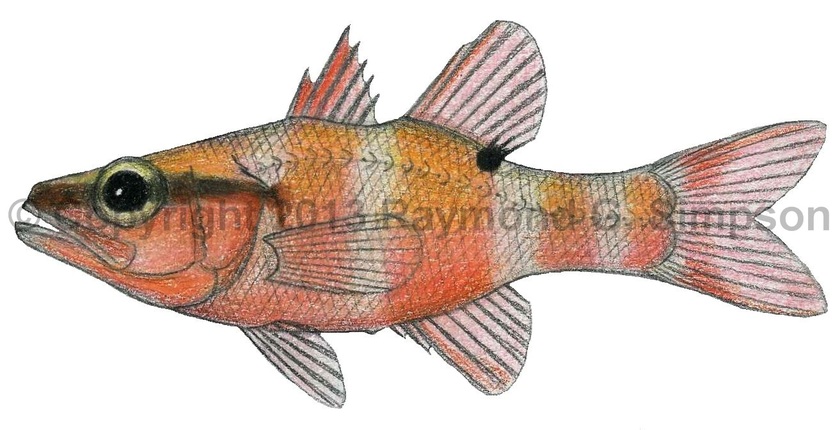
Common Name
Oddscale Cardinalfish
Year Described
Jordan & Snyder, 1904
Identification
Dorsal Fin: VI, I-9
Anal Fin: II, 8
Pelvic Fin: I, 5
Pectoral Fin: 12
Gill Rakers: 4-6 on upper, 15-17 on lower limb; 19-23 total
Vertebrae: 10 precaudal, 14 caudal
Lateral Line Scales: 24
A small fish with a fairly slender and moderately compressed body. The eye is large and the snout long. Mouth is fairly large and oblique, with the lower jaw slightly protruding. Both jaws, palatine, and vomer with narrow bands of villiform teeth (no canines). Preopercular edge with a serrate margin. Preopercular flap does not extend past the preopercular rear margin. There are two dorsal fins. The caudal fin is weakly forked. Body scales ctenoid; lateral line scales much larger than body scales. Predorsal scales 10. Scales around the caudal peduncle 24-28.
Color
Body and head pale to bright red, with or without 3-4 paler body bands (can be faded or darkened). A prominent dark stripe runs from the snout to the opercle. A small dark spot under the rear of the soft dorsal fin has a white spot posterior to it. The fins are pale reddish with darker rays/spines.
Size
Maximum size to 100mm SL.
Habitat
Coral reefs from 3-69m.
Range
Caribbean islands from the Bahamas to Curacao and the continental coast from Cozumel to Colombia. Also the Indo-Pacific.
References
Gon, O. 2002. Apogonidae (pp 1386-1391). In: Carpenter. 2002. The living marine resources of the Western Central Atlantic. Vol. 3: Bony fishes part 2 (Opistognathidae to Molidae), sea turtles and sea mammals. FAO Species Identification Guides for Fisheries Purposes. American Society of Ichthyologists and Herpetologists Special Publication No. 5.
Randall, J.E. and J.E. Böhlke. 1981. The status of the cardinalfishes Apogon evermanni and A. anisolepis (Perciformes: Apogonidae) with description of a related new species from the Red Sea. Proceedings of the Academy of Natural Sciences of Philadelphia v. 133: 129-140, Pl. 1.
Other Notes
Apogon anisolepis is a junior synonym. This name was given to the Atlantic population of the Indo-Pacific A. evermanni, but they appear to refer to a single, wide-ranging species (Randall & Böhlke, 1981). Genetic research might restore the validity of the Atlantic species.
Often classified in a different genus: Zapogon.